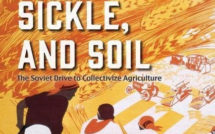

This is part of our Campus Spotlight on the Global Water Initiative at the University of Virginia.
Course Description: In this class we will discuss why sustainability is a problem, and how to measure and evaluate the trade-offs related to different environmental policy choices. We will discuss benefits and drawbacks of various traditional policy solutions such as command and control, permitting, and taxation, and we will discuss new policy tools that are gaining in use: integrated platforms, auctions, tradeable quotas. As part of the class, we will work with a company in Senegal to improve the design of their integrated platform for sanitation management.
This will be primarily a topics-based course, and each class will focus on a different area of sustainability policy. A strong focus of the class will be in understanding issues in the design, implementation, and evaluation of environmental policy. We will evaluate policies designed to reduce water use and pollution, improve air quality, and reduce greenhouse gas emissions. Students will develop their skills in explaining their theory of change and empirical evidence in various forms common to public policy jobs: memos, blog posts, one-pagers, etc. Course readings will include textbooks, policy pieces, blog posts, youtube videos and podcasts, and academic articles.
Recommended:
- Peter Berck and Gloria Helfand. The Economics of the Environment. Pearson. 2011.
- Sachs, Jeffrey. The Age of Sustainable Development. Columbia University Press. 2015.
- Nordhaus, William. The Climate Casino: Risk, Uncertainty and Economics for a Warming World. Yale. 2013.
- William Nordhaus. “Climate Clubs and Carbon Pricing.” in Global Carbon Pricing http://carbon-price.com/wp-content/uploads/Global-Carbon-Pricing-June-2017.pdf.
9/3 Externalities and Common Property resources: What is the role of government?
How do we think about and measure development in terms of the economy-wide big picture?
Readings (prior to first class): Berck and Helfand, Chapter 10.
Garrett Hardin, “The Tragedy of the Commons.” Science. 162:1243-48 (1968).
Ostrom, E. (2008). The challenge of common-pool resources. Environment: Science and Policy for Sustainable Development, 50(4), 8-21
Porter, Michael. (1995). “Green and Competitive, Ending the Stalemate.” Harvard Business Review.
Sachs, Jeffrey. The Age of Sustainable Development. Chapter 1.
Background reading (suggested, not required): Brundtland, Gro Harlem. “Our Common Future,” 1987. http://www.un-documents.net/our-common-future.pdf.
Theory Learning Objectives:
- How can we model public goods and externalities in order to better understand the effect of goods with these properties on the quantity purchased/sold in the market?
- Time discounting
- Behavioral issues in time discounting: procrastination, exponential discounting
- Porter Hypothesis–debate.
- Coase Theorem
- VCG mechanisms
Sustainability in Practice Learning Objectives:
- Why is environmental policy in developing countries important to global sustainability initiatives?
- What determines the success of environmental policy?
- What must be taken into account when we design policy in order to make it as effective as possible?
- What are the issues in evaluating policies surrounding the environment?
- The ethical debate over the allowable level of pollution versus growth—how this may differ between developed and developing countries
9/10 Pollution: Regulation and Policy Levers
What policy levers does the government have available to pull in order to regulate pollution? What are the costs and benefits to these types of regulation? Who are the low cost polluters and who are the high cost polluters?
Readings:
Berck and Helfand, Chapter 12.
Stavins, Robert. (2002). “Experience with Market-Based Environmental Policy Instruments.” Handbook of Environmental Economics.
Jaffe, Peterson, Portney and Stavins. “Environmental Regulation and the Competitiveness of US Manufacturing: What does the Evidence Tell us?” Journal of Economic Literature, 33: 132-163.
Harvard Law Case Study “Limits on the Use of Land Resulting from Property Rights of Another.” S367-s382.
Robert Stavins blogpost. (August, 2017). “Learning from Thirty Years of Experience with Can and Trade Systems.”
Discussion: Boomer v. Atlantic Cement Co
Theory Learning Objectives:
- Modeling Command and Control policies versus Taxation and Quotas.
Sustainability in Practice Learning Objectives:
- Understanding negotiated solutions to environmental problems. When can they work?
- Legal remedies to environmental problems
- Issues in applying legal remedies to sustainability issues
- Writing a theory of change.
9/17 Water and Sanitation:
Improving access to clean water, reducing organic waste through improved sanitation. Market power and integrating markets. How might local governments be better managers of local resources than central governments? What are the drawbacks to allowing management at the local government level?
Readings:
Listen: Planet Money episode 855: poop cartels. (This is related to the project that we will work on in class).
Olmstead (2010) The economics of managing scarce water resources. Review
of Environmental Economics and Policy, 4.
“For want of a drink” The Economist, May 20, 2010.
Geruso, Michael and Spears, Dean, Neighborhood Sanitation and Infant Mortality (January 2017). Available at SSRN: https://ssrn.com/abstract=2605479 or http://dx.doi.org/10.2139/ssrn.2605479
Lipscomb and Mobarak, (2017). Decentralization and Pollution Spillovers. Evidence from the re-drawing of county boundaries. Review of Economic Studies.
Theory Learning Objectives:
- Decentralization, local incentives, and cross-boundary pollution.
- Local management of public goods
Sustainability Policy in Practice Learning Objectives:
- Water pollution and regulation
- Water pricing
- Water use across sectors
- Rationing
- Estimating Demand using pricing data
10/1 Environmental Policy in Developing Countries
costs of pollution and adaptation, decentralized policies, corruption,
Lipscomb, Molly and Ahmed Mushfiq Mobarak. “Decentralization and Pollution Spillovers: Evidence from the Re-drawing of County Borders in Brazil” Review of Economic Studies, January 2017, v84 (1).
Greenstone and Jack. “Envirodevonomics.” Journal of Economic Perspectives.
Hanna and Oliva. (2017). “Implications of Climate Change for Children in Developing Countries.” http://scholar.harvard.edu/files/remahanna/files/implications_of_climate_change.pdf.
Chang, Gross, Graff-Zivin, Neidell. (2017) “The Effect of Pollution on worker productivity: Evidence from Call Center workers.” Vox-Dev blog. https://voxdev.org/topic/energy-environment/effect-pollution-worker-productivity-evidence-call-centre-workers-china
Hsiang, Burke, Miguel. (2013). “Quantifying the Influence of Climate Change on Conflict.” Science.
Discussion with Brandy Lellou, Last Mile Solutions.
EcoHubs for Solar Energy/Water Systems. 9 am.
Theory Learning Objectives:
- Decentralization and Spatial Sorting.
- Environmental Kuznets Curve
Sustainability Policy in Practice Learning Objectives:
- Benefit estimation for environmental regulations
- Impact of Environmental Issues on Health and Development
- Sustainability versus Growth
10/15 Infrastructure
Estimating costs and benefits: Demand for services, costs and benefits of expansion of infrastructure services—heterogeneity in impacts.
Readings:
Lee Miguel Wolfram. Experimental Evidence on the Demand for and Costs of Rural Electrification. NBER working paper #22292.
Duflo and Pande. Dams. https://scholar.harvard.edu/files/rpande/files/dams_0.pdf.
“Valuing the Environment through Contingent Valuation” Michael Hanemann, Journal of Economic Perspectives. 8(4) 19-43. 1994.
“Contingent Valuation: Is some Number Better than no Number?” Peter A. Diamond and Jerry A. Hausman. Journal of Economic Perspectives 8(4): 45-64. Fall, 1994.
International Growth Center youtube video. (2018) “Ghana’s Infrastructure: The Mystery of Misspending.”
Berck and Helfand Chapter 6,7
https://www.seforall.org/
In class activity: Alternatives to stated preferences: Becker-Degroot Marshack Mechanism
Theory Learning Objectives:
- Estimating demand—stated preference and revealed preferences methods.
Sustainability Policy in Practice Learning Objectives:
- Writing a survey including stated preferences components
- Estimating values from stated preferences
- Issues with stated preferences valuation
- Discussion with Graham Baldwin. Invenergy. www.invenergyllc.com
10/22 Energy
Incentives for investment, impacts, decisions of where to invest, NIMBY, environmental justice.
Wolfram, Catherine, Orie Shelef, and Paul Gertler, “How Will Energy Demand Develop in the Developing World?,” Journal of Economic Perspectives, 2012, 26, 119–138
Jack and Smith. (2017) Charging Ahead. https://www.theigc.org/wp-content/uploads/2017/07/Jack-Smith-2017-Working-paper.pdf
Gupta and Spears, (2017). “Health Externalities of India’s Expansion of coal plants: Evidence from a National panel of 40,000 households.” Journal of Environmental Economics and Management.
Video: Greenstone, “The Global Energy Challenge” (3 minutes).
Design and structure of RGGI: https://www.rggi.org/program-overview-and-design/elements
Discussion with Bill Shobe. RGGI.
10/29 Agricultural Productivity.
adoption of new technologies, land tenure reforms, supply chains, and integrating markets
Chari, Amalavoyal, Elaine Liu, Yongxiang Wang, and Shing-Yi Wang. (2018) “Land Rights and Agricultural Efficiency.” Vox-Dev https://voxdev.org/topic/agriculture/land-rights-and-agricultural-efficiency
Goldstein, Markus and Christopher Udry, “The profits of power: Land rights and agricultural investment in Ghana,” Journal of Political Economy, 2008, 116 (6), 981–1022.
Casaburi, Dillon, Reed. (2017) “Agricultural Markets in ‘Rising Africa’” vox dev. https://voxdev.org/topic/agriculture/agricultural-markets-rising-africa
Conley and Udry, (2010) “Learning about a New Technology: Pineapple in Ghana.” Econometrica.
Theory Learning Objectives:
- Measuring learning when there may be learning from others.
- Information diffusion through neighborhoods.
Sustainability Policy in Practice Learning Objectives:
- How can we design marketing/information campaigns to better change behavior at the farm level?
11/15 Global Food System and Food Security
Returns to Scale, Impacts from pollution and climate change
Aragon and Rud, (2015). “Polluting Industries and Agricultural Productivity: Evidence from Mining in Ghana.” Economic Journal.
Jackie Savitz. “Save the Oceans, feed the world.” https://www.ted.com/talks/jackie_savitz_save_the_oceans_feed_the_world
Sekhri, Sheetal “ Wells, Water and Welfare: Impact of Access to Groundwater on Rural Poverty and Conflict” (American Economic Journal: Applied Economics, July 2014, Vol. 6(3): 76-102)
Sachs The Age of Sustainable Development, Chapter 13
Berck and Helfand: Chapters 16 and 17
11/12 Deforestation
Payments for Environmental Services
Readings:
Jayachandran (2017). “Cash for Carbon: A Randomized Trial of Payments for Ecosystem services to reduce Deforestation.” Science.
Jack and Jayachandran. (2018) “Self-selection into payments for eco-system services programs.” PNAS.
Case Study
Discussion with Elizabeth Vranas, UVA alum and Northeast Conservation Manager, American Forest Foundation.
Theory Learning Objectives:
- Additionality
- Selection into take-up of a program.
Sustainability Policy in Practice Learning Objectives:
- Key components of PES programs.
- How do you determine prices and expected level of take-up? What happens if you get it wrong?
11/19 Extractive Industries
Syed Faraz Ahmed. “The Global Cost of E-Waste.” The Atlantic. Sep 2016.
Hsiang and Sekar. “Does Legalization reduce black market activity? Evidence from a Global Ivory Experiment and Elephant Poaching Data.
The Rhino Hunter. Radiolab 2015.
Diamond mining and auctions https://www.gia.edu/gems-gemology/winter-2014-rough-diamond-auctions-changes-pricing-distribution.
Paul Lewis. 1996. Blood and Oil: A Special Report; After Nigeria Represses, Shell Defends its Record. New York Times.
Berck and Helfand. Chapter 16.
Theory Learning Objectives:
- The Hotelling Model
- Harvest Functions
- Effort-Yield Curves
Sustainability Policy in Practice Learning Objectives:
- Effective management of natural resources
- Ivory and the experiment with temporary sales
- Permit methods of rationing.
11/26 Climate Change Part 1: Measuring Damages.
The Daily (New York Times Podcast). “When we almost stopped Climate Change.” August 30, 2018.
Hsiang Burke Miguel. (2013) “Quantifying the Influence of Climate on Human Conflict.” Science.
Burke, Davis, Diffenbaugh. “Large Potential reduction in economic damages under UN mitigation targets.” Nature 557, 549-553.
Aufhammer, Maximilian. (2017) “Grand Damage Projections.” Nature.
Schlenker, Wolfram (2017) “Feeling the Heat.” Nature.
Carleton, Delgado, Greenstone et al. “Valuing the Global Mortality Consequences of Climate Change: Accounting for Adaptation Costs and Benefits.
Economic Survey of India, 2018. http://mofapp.nic.in:8080/economicsurvey/pdf/082-101_Chapter_06_ENGLISH_Vol_01_2017-18.pdf
Berck and Helfand. Chapter 14.
Theory Learning Objectives:
- Measuring Costs when Adaptation is common.
- Cost uncertainty and tail events
- Discount rates and present value
12/3 Climate Change Part 2: Negotiations, Dominant Strategies, Nash Equilibrium, Incentive Compatability, Individual Rationality, and Policy Solutions.
How can game theory help to explain the difficulties in negotiating climate treaties? What is Carbon Pricing and what are the benefits and drawbacks of this policy?
Readings:
Sachs, The Age of Sustainable Development, Chapter 12.
Robert Stavins Blogpost. (April 8, 2018). “Reflections on Economics and Policy Making in the Environmental Domain.”
Dietz and Stern (2008) Why economic analysis supports strong action on
climate change: a response to the Stern Review’s critics. Review of
Environmental Economics and Policy, 2.
Stern Review: http://www.webcitation.org/5nCeyEYJr
Nicholas Stern “State of the Climate and What we Might Do about it.” https://www.ted.com/talks/lord_nicholas_stern_the_state_of_the_climate_and_what_we_might_do_about_it
Nordhaus (2011). “The economics of tail events with an application to climate change. Journal of Economic Literature. 45(3).
Gollier and Tirole. “Effective Institutions against climate change.” Global Carbon Pricing. Http://carbon-price.com/wp-content/uploads/Global-Carbon-Pricing-June-2017.pdf.
Theory Learning Objectives:
- Nash Equilibrium, Incentive Compatibility and individual Rationality
Sustainability Policy in Practice Learning Objectives:
- Bargaining between sovereign states.
- Carbon Pricing
These are syllabi of water courses or courses with significant water content from colleagues affiliated with the Global Water Initiative at the University of Virginia.
Published on December 11, 2018.




